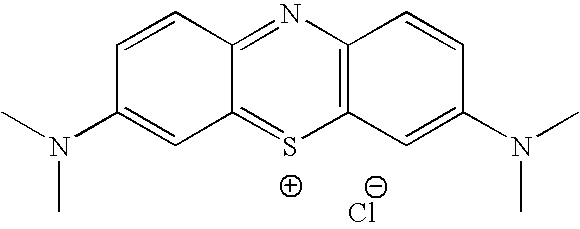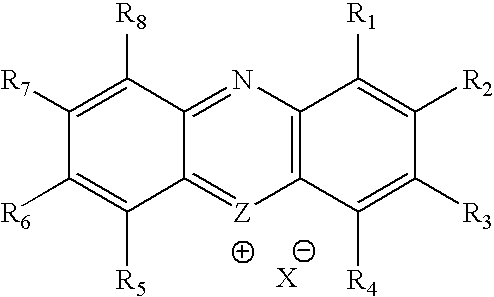Methylene Blue Derivatives
a technology of methylene blue and derivatives, which is applied in the direction of organic active ingredients, organic chemistry, and heterocyclic compound active ingredients, can solve the problems that pharmaceutical manufacturers are generally unwilling to manufacture dosage forms, and achieve the effects of less staining formulations, less hydrophobic compositions, and rapid uptake and clearan
- Summary
- Abstract
- Description
- Claims
- Application Information
AI Technical Summary
Benefits of technology
Problems solved by technology
Method used
Image
Examples
example 1
Synthesis of the Dodecylsulfate Salt of Methylene Blue
[0074] 27.77 g (86.8 mmol) of methylene blue chloride and 50 g (173.3 mmol) of sodium dodecylsulfate were heated at reflux for 24 h in 1.7 L of CH2Cl2 and 250 ml of water. The layers were seprated, and the organic phase was washed with wat er (3×200 ml), and dried over sodium sulfate. Filtration and concentration gave 18.89 g of the dodecylsulfate salt of methylene blue. The structure of methylene blue dodecylsulfate was confirmed by 1H NMR and mass spectrometry. Elemental analysis showed that chlorine was not present in the product, indicating that the product was free of methylene blue chloride.
example 2
Preparation of Co-Melts of Methylene Blue Dodecyl Sulfate and Stearic Acid
[0075] Stearic acid was placed in a scintillation vial and the stearic acid was melted in an oil bath at 95° C. Methylene blue dodecylsulfate (MBDS) was added to the molten stearic acid (SA) and mixed well until a homogenous mixture was obtained (approximately 10-15 minutes). The uniform melt as poured onto an aluminum foil tray and allowed to solidify, resulting in a thin layer of the mixture. No distinct MBDS particles were observed in the molten or solidified product when a 1:10 ratio of MBDS:SA was used. MEDS insoluble particles were observed when a 1:2 ratio of MBDS:SA was used. All solubility studies were conducted using a composition with a 1:10 ratio. The ratios werfe calculated based on the methylene blue chloride equivalent.
[0076] This study demonstrated that MEDS dissolves in molten stearic acid and remains incorporated in the stearic acid matrix upon solidifying, indicating that MBDS dissolved in...
example 3
Solubility of Methylene Blue Dodecylsulfate and Methylene Blue Dodecylsulfate-Stearic Acid Co-melts
[0077] Known amounts of methylene blue chloride (MBC), methylene blue dodecylsulfate (MBDS), and methylene blue dodecylsulfate-stearic acid melt (MBDS-SA) were each placed in a scintillation vial. The solubility of the compound was evaluated by adding 4 ml of deionized water, phosphate buffer, or phosphate buffeer containing 0.75% Tween 20 and 0.15 M NaCl to the vials. The vials were sealed and shaken at 250 rpm using a bench top shaker at room temperature for at least 24 hours. The samples were centrifuged and the superantant was collected for analysis. Each vial contained some non-dissolved material indicating that a saturated solution had been obtain. The results are shown in Table 1.
TABLE 1Solubility (mg / ml) given as Methylene Blue Chloride equivalentphosphate buffer pH 6.8 with 0.75%de-ionized waterphosphate buffer pH 6.8(w / w) Tween 20 and 0.15 M NaClSamplesample 1sample 2Avera...
PUM
| Property | Measurement | Unit |
|---|---|---|
| melting point | aaaaa | aaaaa |
| pH | aaaaa | aaaaa |
| pH | aaaaa | aaaaa |
Abstract
Description
Claims
Application Information
 Login to View More
Login to View More - R&D
- Intellectual Property
- Life Sciences
- Materials
- Tech Scout
- Unparalleled Data Quality
- Higher Quality Content
- 60% Fewer Hallucinations
Browse by: Latest US Patents, China's latest patents, Technical Efficacy Thesaurus, Application Domain, Technology Topic, Popular Technical Reports.
© 2025 PatSnap. All rights reserved.Legal|Privacy policy|Modern Slavery Act Transparency Statement|Sitemap|About US| Contact US: help@patsnap.com



